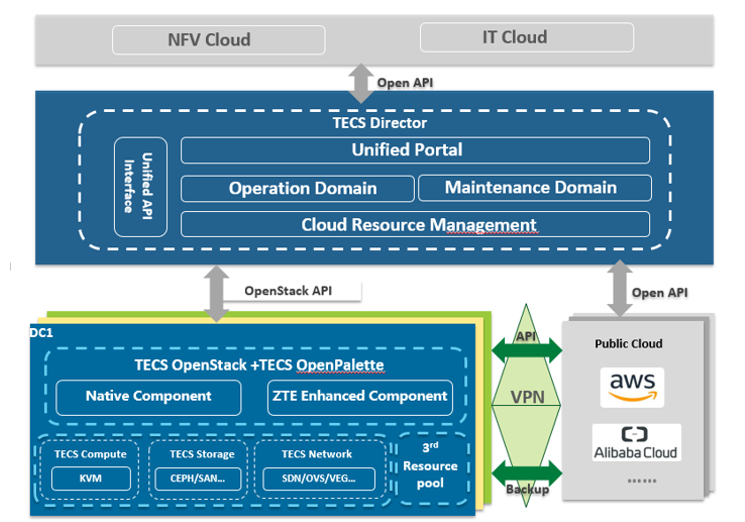ZTE hybrid cloud solution, meeting various service demands of 5G
Time:2018-11-16
With the acceleration of the 5G era, rich and diverse Internet services have emerged. More and more enterprises use different cloud service models to solve the problem of rapid service deployment according to the business type.
Public Cloud is a kind of technology leveraging external Internet resources to gain IT resources and IT services and to deploy information applications. Large and medium-sized enterprises can obtain efficient computing power and low-cost operation and maintenance (O&M) services on the public cloud, so as to deploy services easily and quickly. However, these enterprises have to face problems of large volume, complex organization, and service data security, which makes them worry when using public clouds.
Private Cloud is a technology that integrates resources and streamlines based on internal resource pools on the basis of enterprise IT virtualization, to meet specific IT requirements. Private clouds have the advantages of wide coverage, complete infrastructure, as well as reliable and secure data, which can meet the needs of enterprises' comprehensive service deployment. However, due to the high costs of construction and O&M of private clouds, many enterprises are discouraged.
Hybrid Cloud is a combination of private cloud and public cloud. It can take advantages of both and take into account the IT construction ideas developed by traditional IT technology architecture. It combines the security and controllability of private cloud. And the economics, efficiency and scalability of public clouds.
ZTE proposes the hybrid cloud solution, fully considering the advantages and disadvantages of private and public clouds in a multi-cloud coexistence environment, to build a hybrid cloud platform by unifying private and public clouds. Operators can adopt the optimal distributed deployment mode by deploying private cloud at edge and deploying public cloud for core data center to meet the demands of future 5G multi-service development. This is also the main mode and development trend of cloud computing in recent years. The solution utilizes the reliability of private cloud to store important data of public cloud in the local data center, and can also lease flexibly-expandable computing resources of public cloud to complete the work more efficiently and quickly. The 5G-oriented hybrid cloud platform solution is also the best interpretation of absorbing advantages of different sides.
It has the following features:
More convergent: The hybrid cloud solution is able to integrate with interfaces of many mainstream public cloud providers (Alibaba Cloud, Tencent Cloud, etc.), and encapsulate them as a unified interface for the infrastructure layer to implement unified allocation, utilization and monitoring on compute, network and storage resources in the hybrid cloud, to realized unified management of private and public clouds. When services lease resources flexibly from the pubic cloud if resources of private cloud are not sufficient, the solution shields the differences of private cloud and public cloud for MANO and APP, and provides consistence services. It is an end-to-en one-stop solution.
More compatible: The cloud platform carries out unified management of multiple physical machine / virtual machine / container pools, multi-vendor heterogeneous resource pools and various acceleration hardware resources, to achieve optimal deployment and dynamic adjustment of resources. In case of peak service load, it allocates services to the public cloud and private cloud according resource load, to achieve smooth inter-cloud service migration and flexible service handover.
Easy to maintain: The distributed architecture based on “Center + Edge + Access”data centers (DC), achieves hyper-convergent deployment and unmanned O&M at the edge, carries out AI-based prediction and big data analysis at the core, provides visual network topology, intelligent patrol, alarm self-healing and health analysis, achieving unified O&M, backup and upgrading of core DC.
More secure: The private cloud is established by the operator exclusively, to perform the most efficient control on data security and service quality. Based on the distributed storage system, the data of public cloud can be recovered to the private cloud through cross-cloud disaster recovery and backup, achieving carrier-grade reliability.
More economical: This solution protects original investments on private cloud, and makes full use of private cloud and public cloud resources. According to service features, the operator can deploy applications to adaptive resources, such as deploying control plane VNFs to the core public cloud, and deploying forwarding plane VNFs to the edge private cloud, to reduce investment cost. In addition, in case of traffic peek and disaster recovery, operators can flexibly lease public cloud for dynamic resource scheduling according to service features. After the event, resources are returned quickly, improving resource utilization rate.

ZTE hybrid cloud solution has fully considered operators’ service demands and investment costs, and has introduced container to assist cloud native evolution. The unified management of hybrid cloud resource achieves smooth upgrading of 5G network. It provides cross-cloud services to address rapid deployment of 5G services. This solution technically shields underlying physical details and realization details, reducing operators’ trial and error costs, and achieving flexible service deployment and rapid onboarding based on the hybrid cloud. Thus, the customization capability of private cloud and sharing and ecological capabilities of public cloud are converged organically, guaranteeing operators’ services moving on private cloud and public cloud freely, and these services will be well protected, applied and shared.

